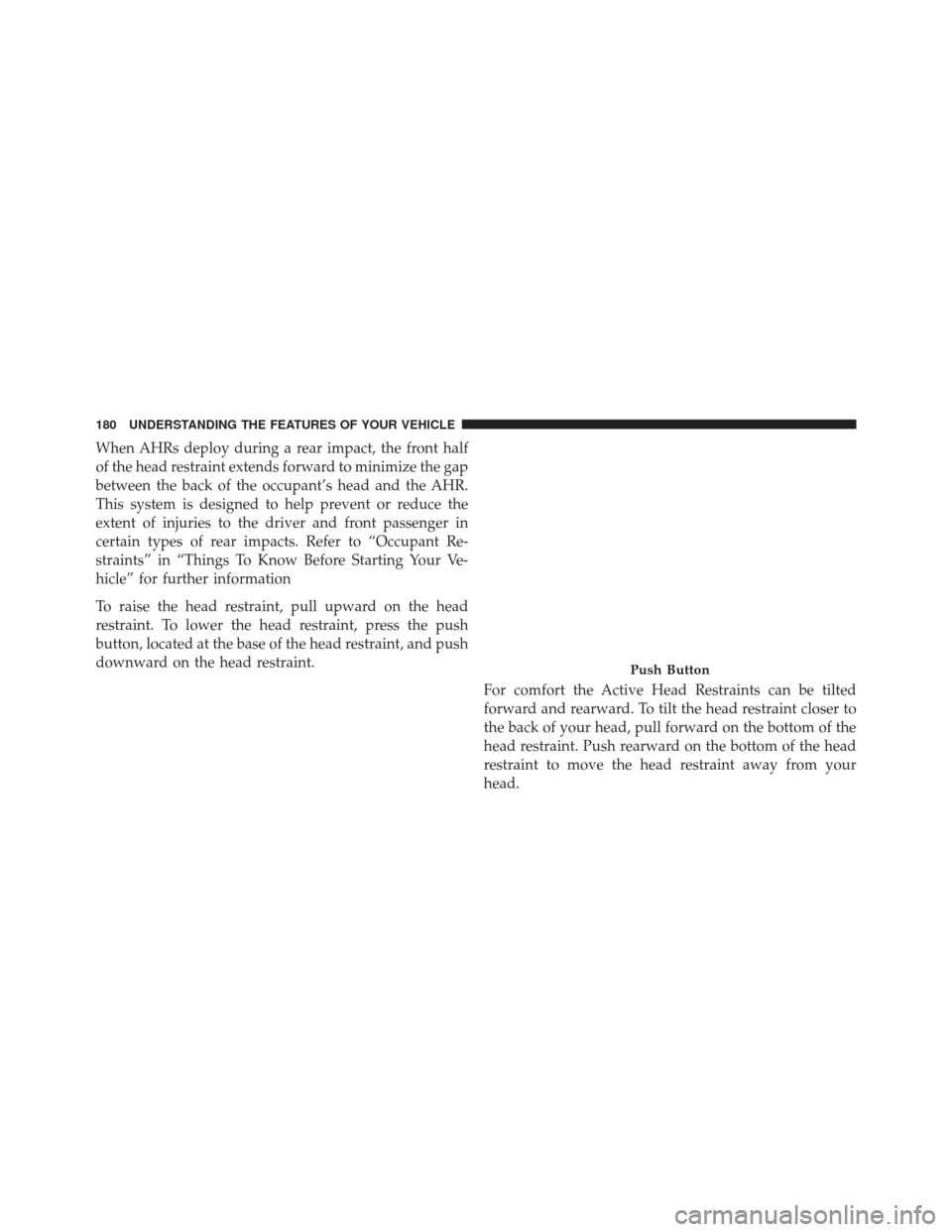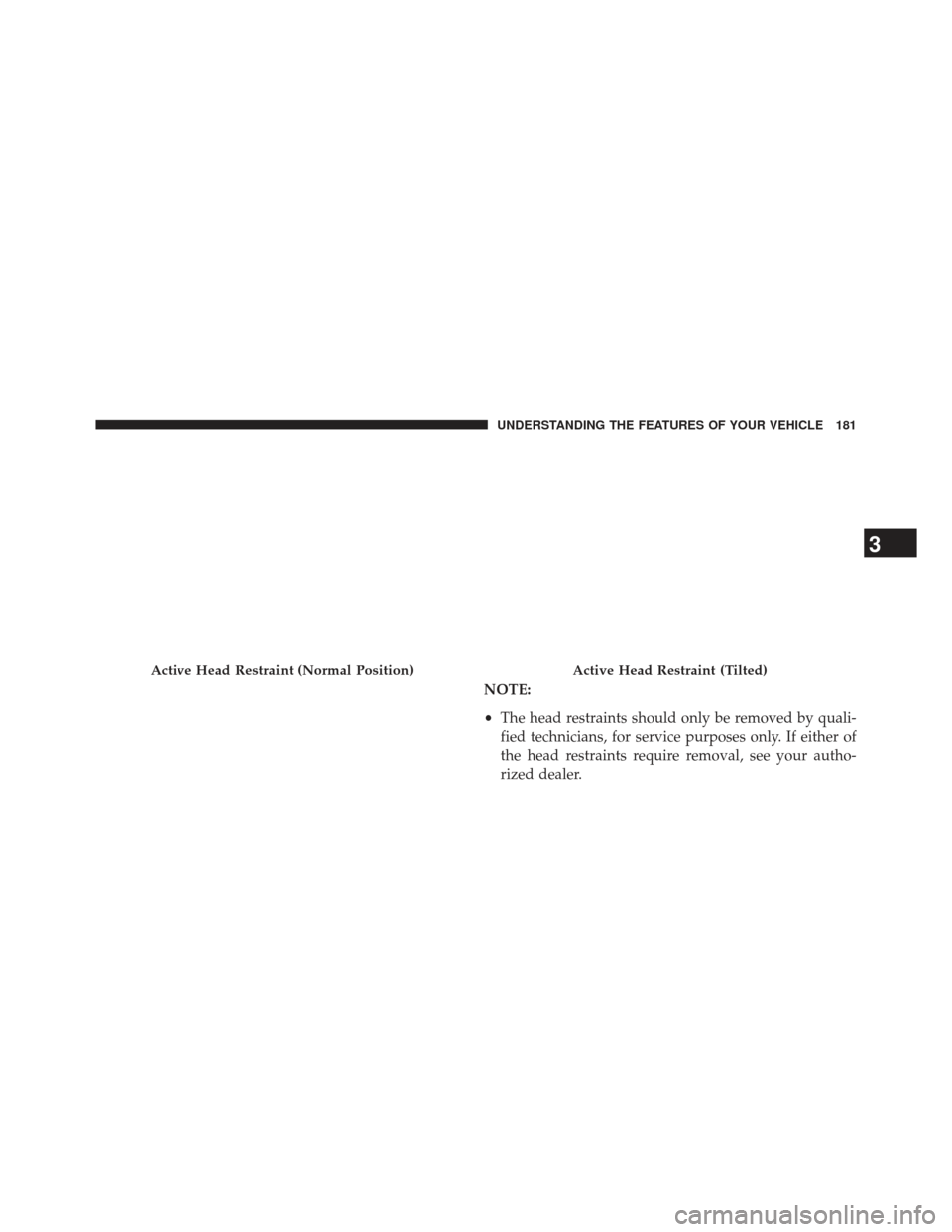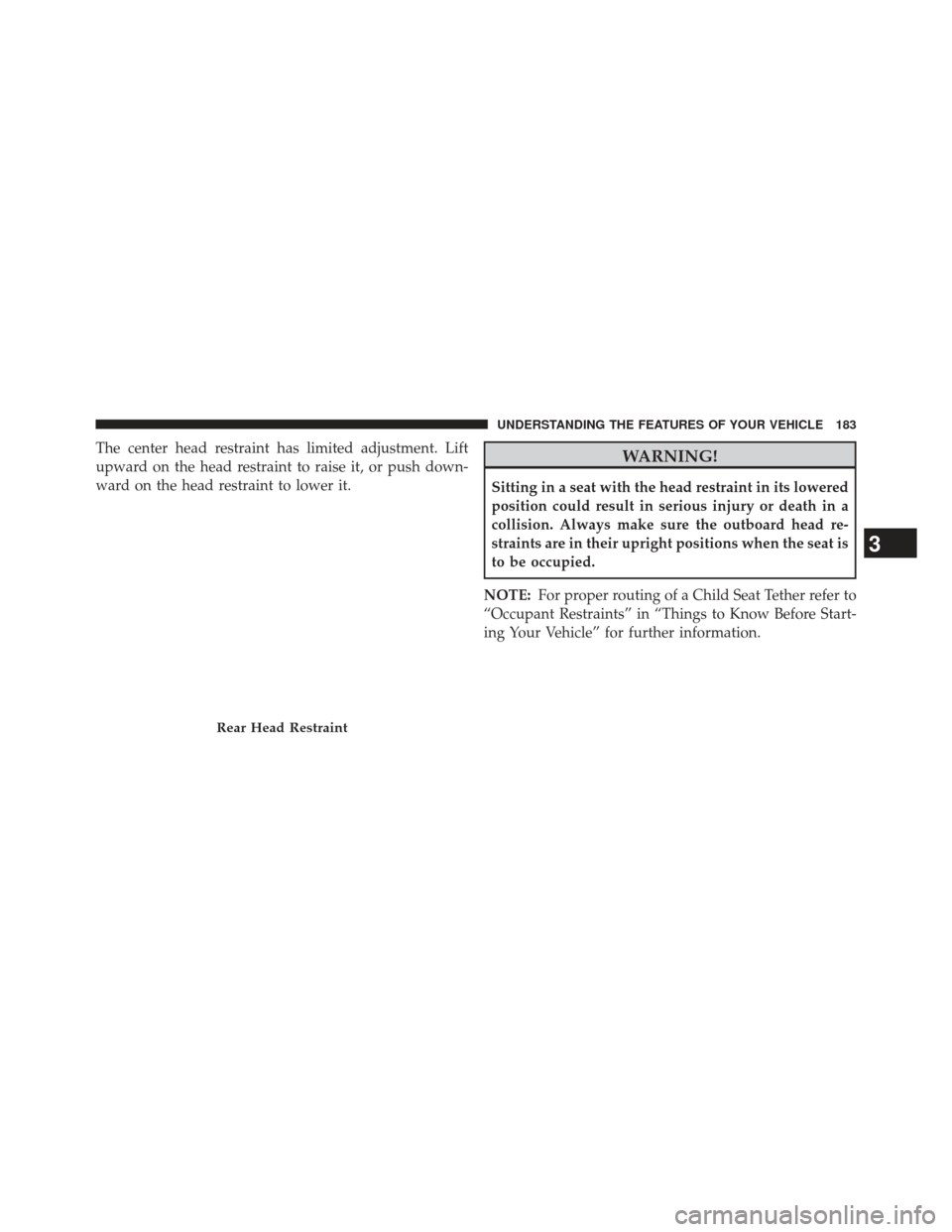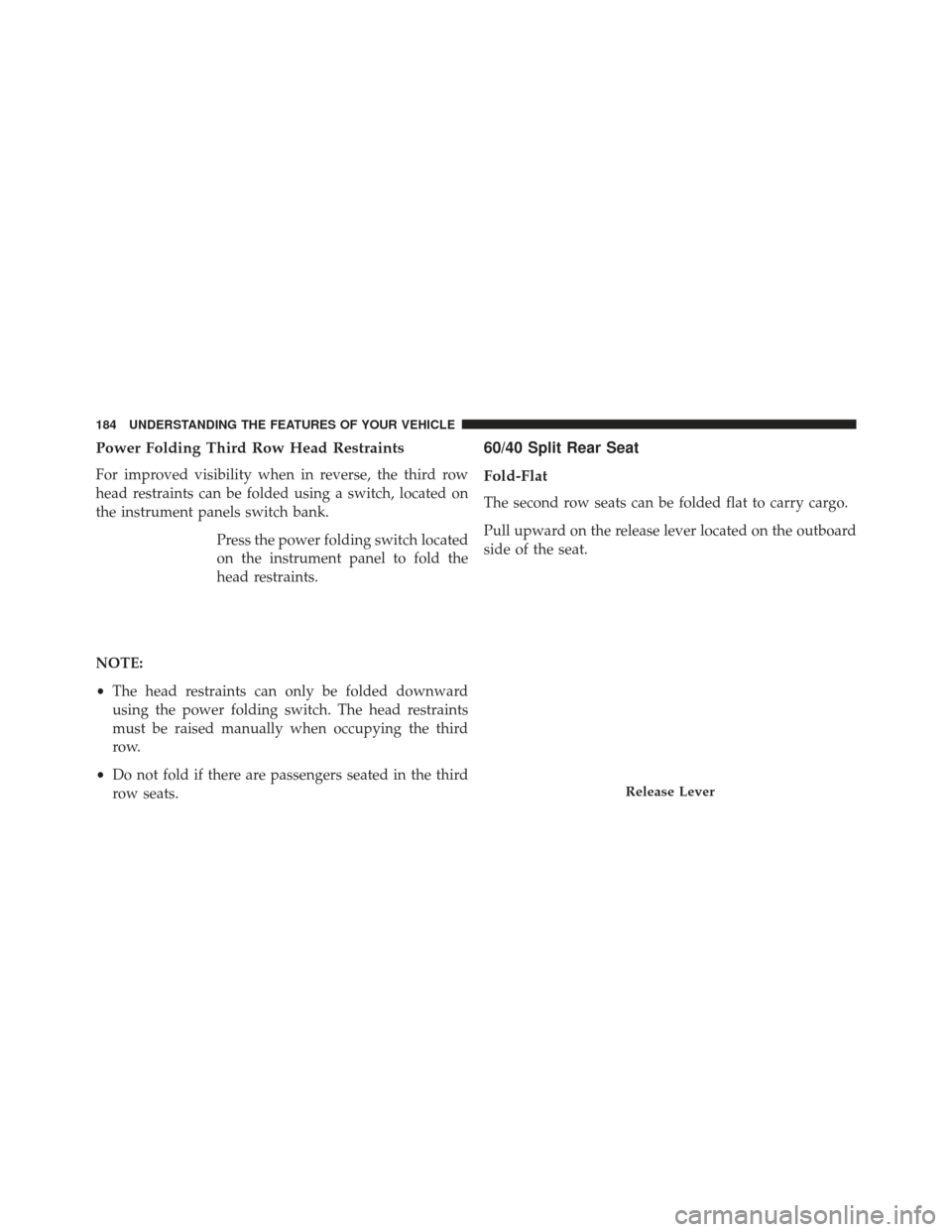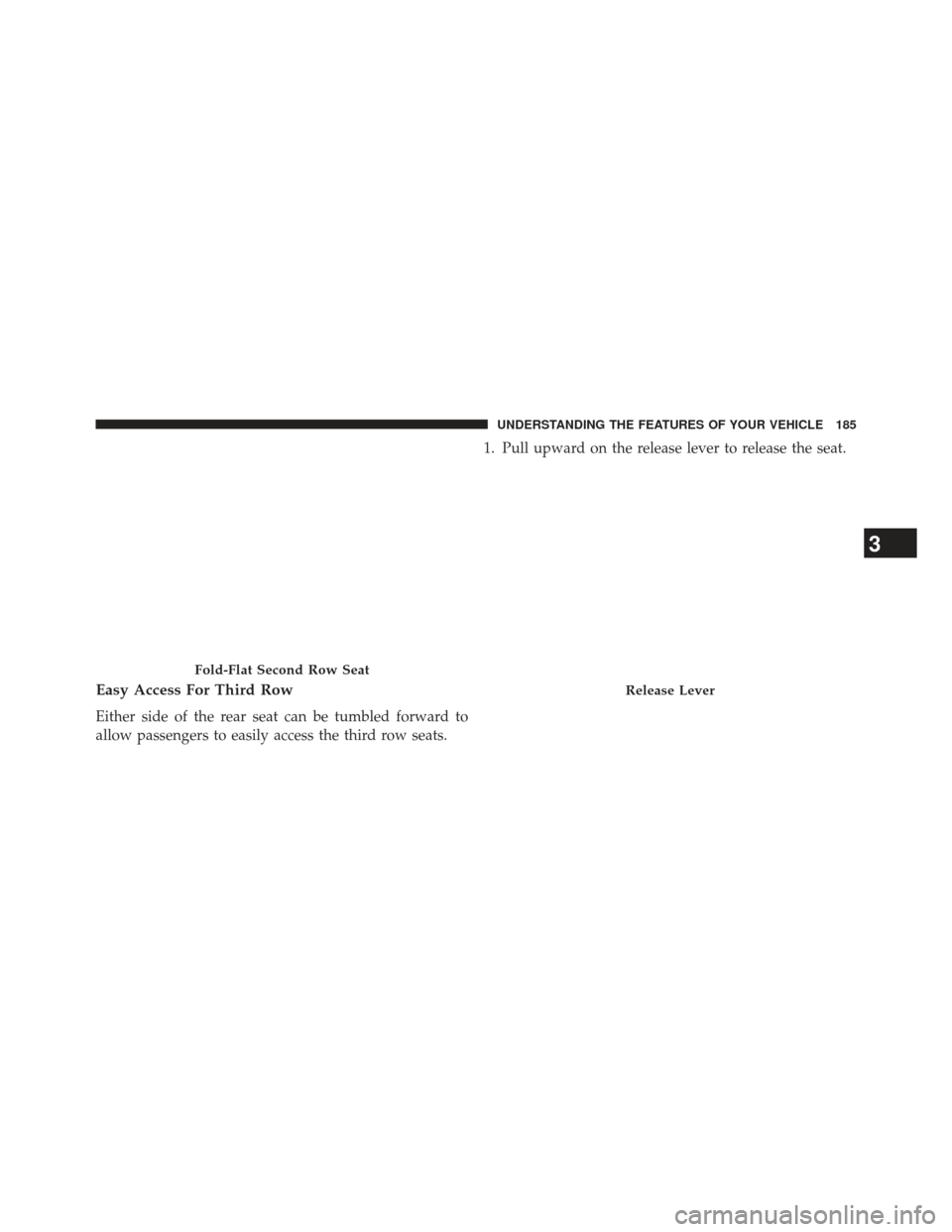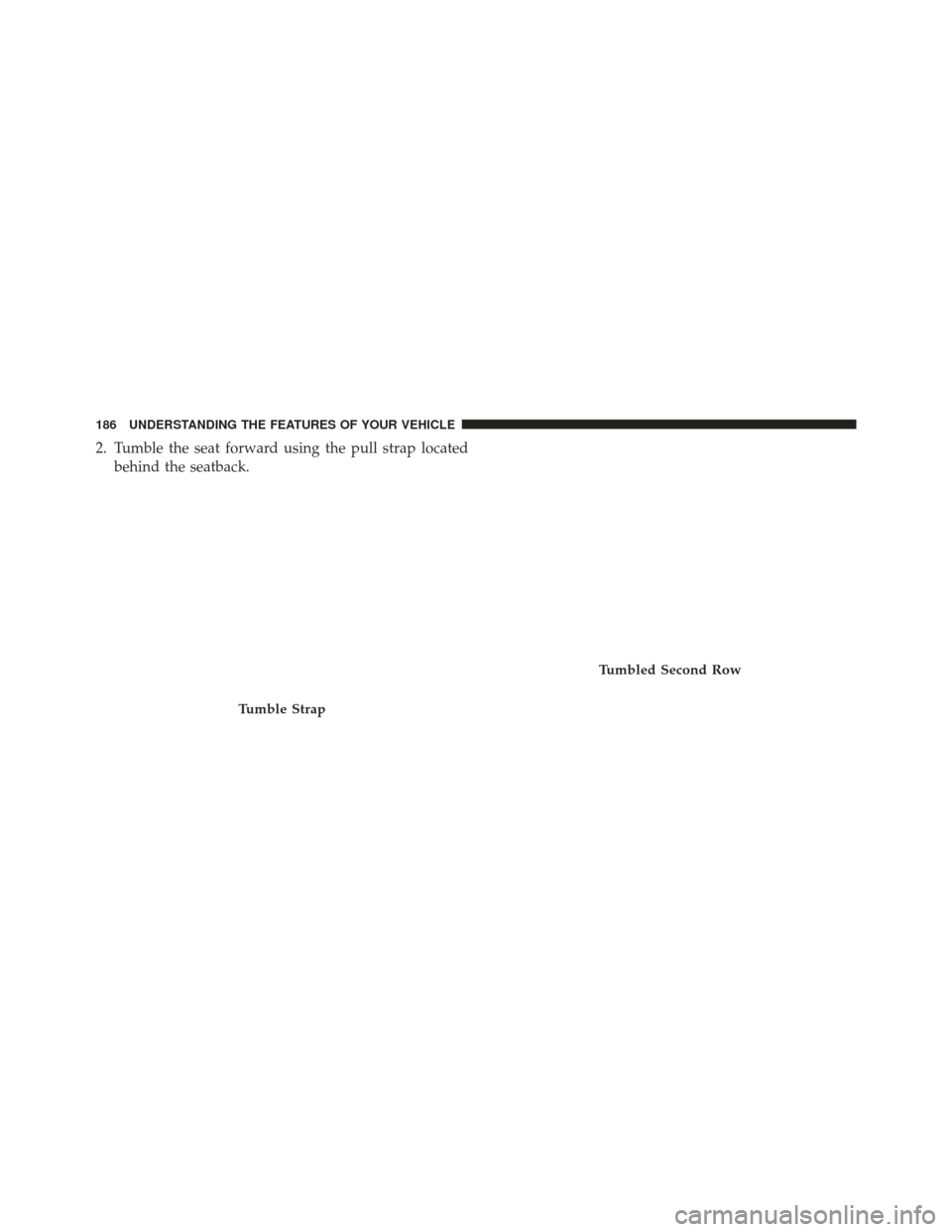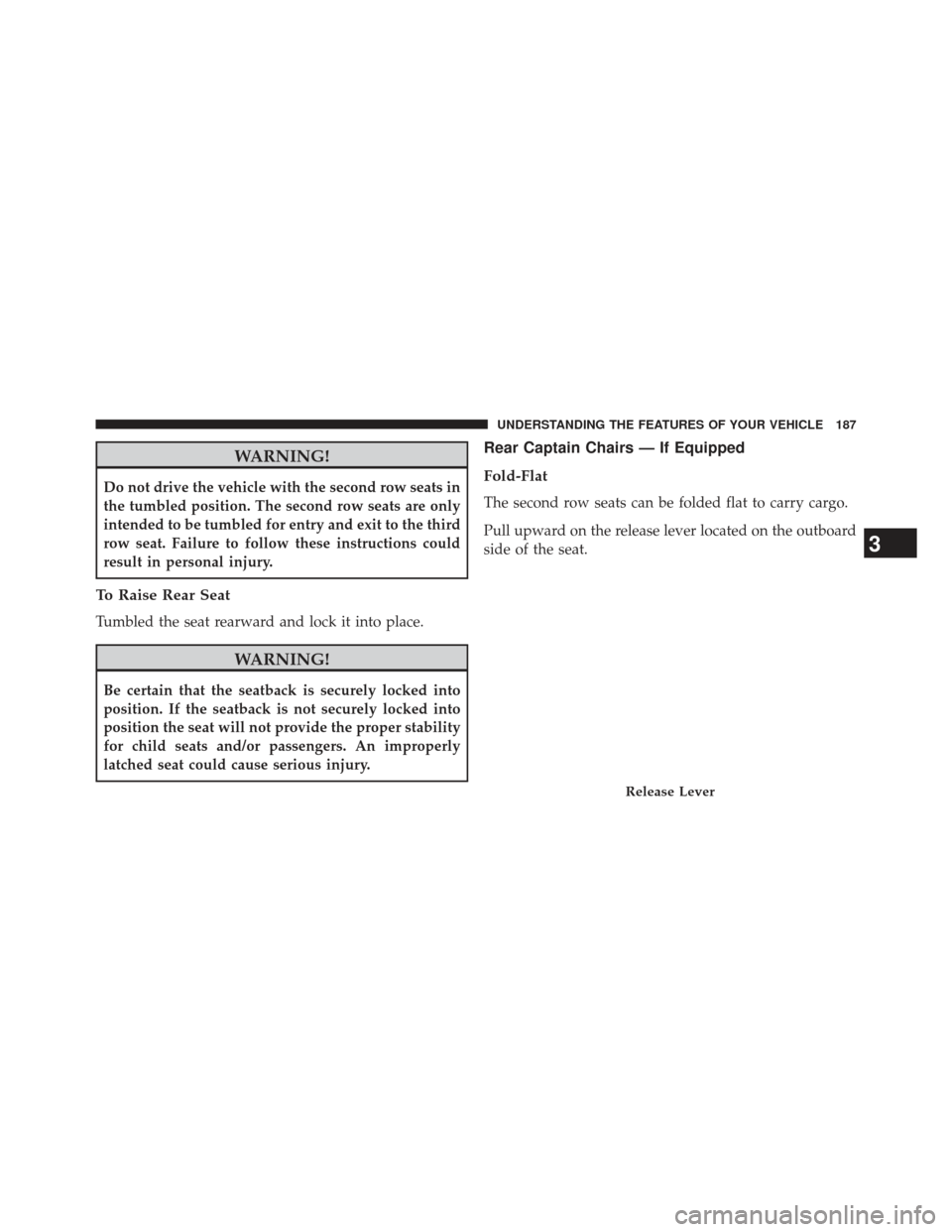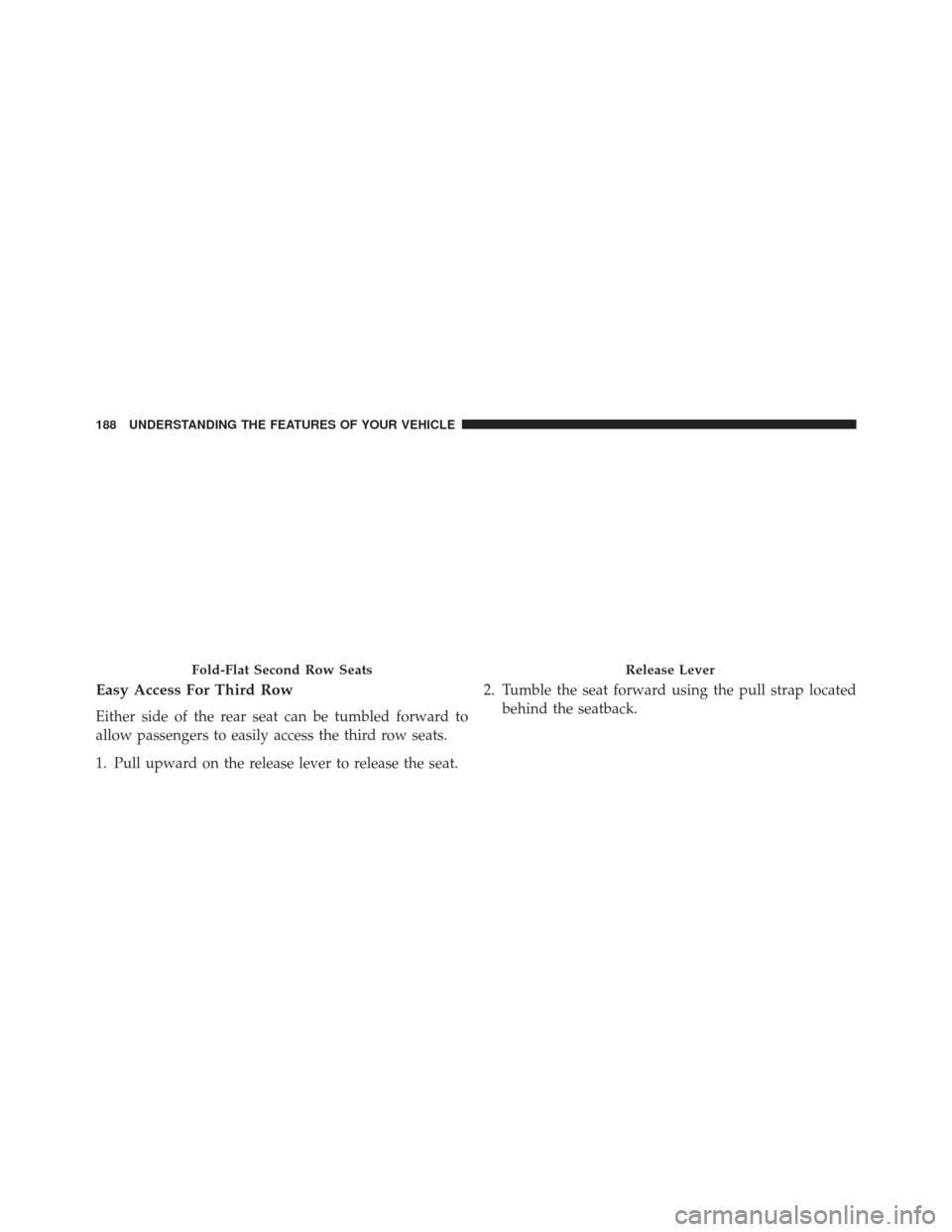DODGE DURANGO 2013 3.G Owners Manual
DURANGO 2013 3.G
DODGE
DODGE
https://www.carmanualsonline.info/img/12/5613/w960_5613-0.png
DODGE DURANGO 2013 3.G Owners Manual
Trending: radio controls, low beam, tire size, battery, low oil pressure, belt, clock setting
Page 181 of 699
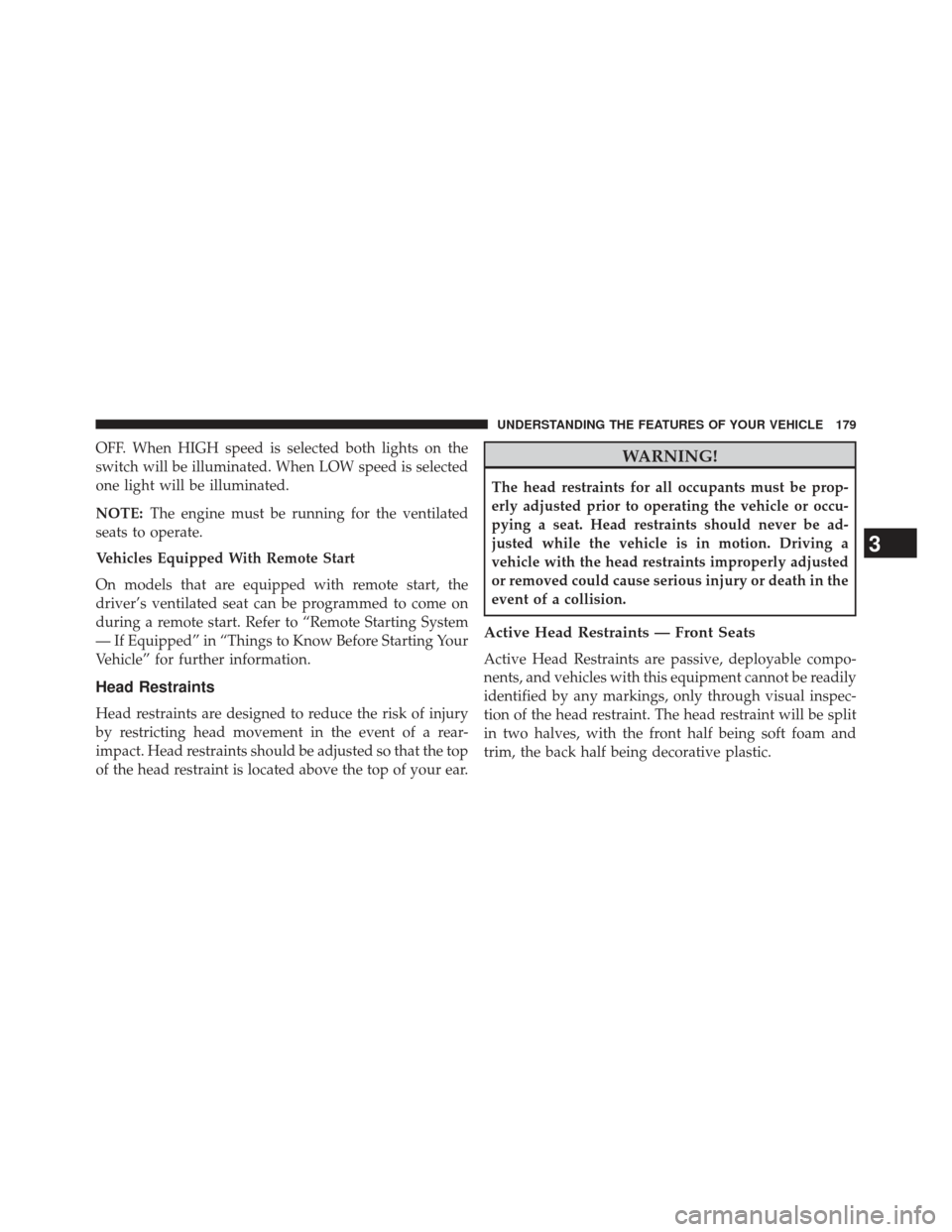
OFF. When HIGH speed is selected both lights on the
switch will be illuminated. When LOW speed is selected
one light will be illuminated.
NOTE:The engine must be running for the ventilated
seats to operate.
Vehicles Equipped With Remote Start
On models that are equipped with remote start, the
driver’s ventilated seat can be programmed to come on
during a remote start. Refer to “Remote Starting System
— If Equipped” in “Things to Know Before Starting Your
Vehicle” for further information.
Head Restraints
Head restraints are designed to reduce the risk of injury
by restricting head movement in the event of a rear-
impact. Head restraints should be adjusted so that the top
of the head restraint is located above the top of your ear.
WARNING!
The head restraints for all occupants must be prop-
erly adjusted prior to operating the vehicle or occu-
pying a seat. Head restraints should never be ad-
justed while the vehicle is in motion. Driving a
vehicle with the head restraints improperly adjusted
or removed could cause serious injury or death in the
event of a collision.
Active Head Restraints — Front Seats
Active Head Restraints are passive, deployable compo-
nents, and vehicles with this equipment cannot be readily
identified by any markings, only through visual inspec-
tion of the head restraint. The head restraint will be split
in two halves, with the front half being soft foam and
trim, the back half being decorative plastic.
3
UNDERSTANDING THE FEATURES OF YOUR VEHICLE 179
Page 182 of 699
When AHRs deploy during a rear impact, the front half
of the head restraint extends forward to minimize the gap
between the back of the occupant’s head and the AHR.
This system is designed to help prevent or reduce the
extent of injuries to the driver and front passenger in
certain types of rear impacts. Refer to “Occupant Re-
straints” in “Things To Know Before Starting Your Ve-
hicle” for further information
To raise the head restraint, pull upward on the head
restraint. To lower the head restraint, press the push
button, located at the base of the head restraint, and push
downward on the head restraint.For comfort the Active Head Restraints can be tilted
forward and rearward. To tilt the head restraint closer to
the back of your head, pull forward on the bottom of the
head restraint. Push rearward on the bottom of the head
restraint to move the head restraint away from your
head.
Push Button
180 UNDERSTANDING THE FEATURES OF YOUR VEHICLE
Page 183 of 699
NOTE:
•The head restraints should only be removed by quali-
fied technicians, for service purposes only. If either of
the head restraints require removal, see your autho-
rized dealer.
Active Head Restraint (Normal Position)Active Head Restraint (Tilted)
3
UNDERSTANDING THE FEATURES OF YOUR VEHICLE 181
Page 184 of 699
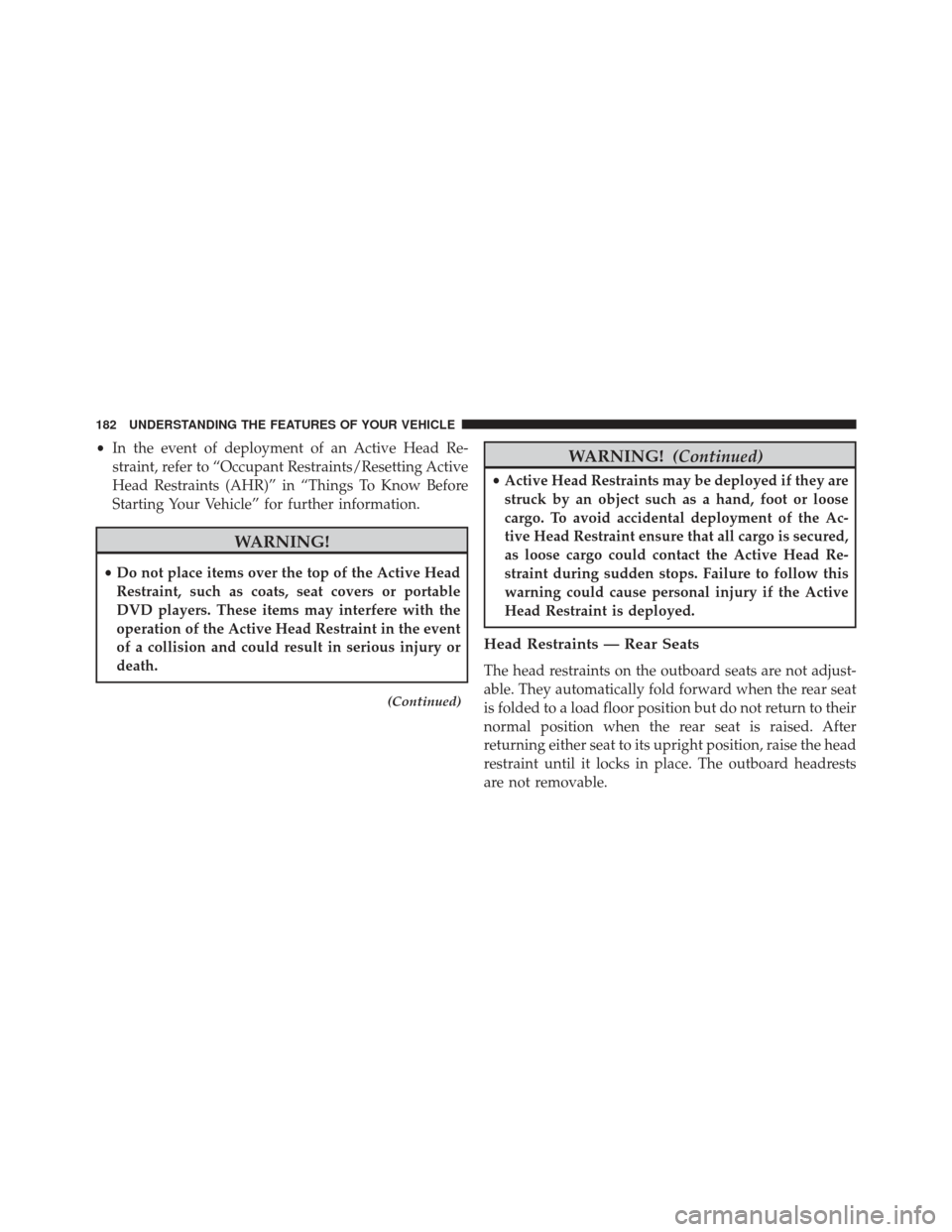
•In the event of deployment of an Active Head Re-
straint, refer to “Occupant Restraints/Resetting Active
Head Restraints (AHR)” in “Things To Know Before
Starting Your Vehicle” for further information.
WARNING!
• Do not place items over the top of the Active Head
Restraint, such as coats, seat covers or portable
DVD players. These items may interfere with the
operation of the Active Head Restraint in the event
of a collision and could result in serious injury or
death.
(Continued)
WARNING! (Continued)
•Active Head Restraints may be deployed if they are
struck by an object such as a hand, foot or loose
cargo. To avoid accidental deployment of the Ac-
tive Head Restraint ensure that all cargo is secured,
as loose cargo could contact the Active Head Re-
straint during sudden stops. Failure to follow this
warning could cause personal injury if the Active
Head Restraint is deployed.
Head Restraints — Rear Seats
The head restraints on the outboard seats are not adjust-
able. They automatically fold forward when the rear seat
is folded to a load floor position but do not return to their
normal position when the rear seat is raised. After
returning either seat to its upright position, raise the head
restraint until it locks in place. The outboard headrests
are not removable.
182 UNDERSTANDING THE FEATURES OF YOUR VEHICLE
Page 185 of 699
The center head restraint has limited adjustment. Lift
upward on the head restraint to raise it, or push down-
ward on the head restraint to lower it.WARNING!
Sitting in a seat with the head restraint in its lowered
position could result in serious injury or death in a
collision. Always make sure the outboard head re-
straints are in their upright positions when the seat is
to be occupied.
NOTE: For proper routing of a Child Seat Tether refer to
“Occupant Restraints” in “Things to Know Before Start-
ing Your Vehicle” for further information.
Rear Head Restraint
3
UNDERSTANDING THE FEATURES OF YOUR VEHICLE 183
Page 186 of 699
Power Folding Third Row Head Restraints
For improved visibility when in reverse, the third row
head restraints can be folded using a switch, located on
the instrument panels switch bank.Press the power folding switch located
on the instrument panel to fold the
head restraints.
NOTE:
• The head restraints can only be folded downward
using the power folding switch. The head restraints
must be raised manually when occupying the third
row.
• Do not fold if there are passengers seated in the third
row seats.
60/40 Split Rear Seat
Fold-Flat
The second row seats can be folded flat to carry cargo.
Pull upward on the release lever located on the outboard
side of the seat.
Release Lever
184 UNDERSTANDING THE FEATURES OF YOUR VEHICLE
Page 187 of 699
Easy Access For Third Row
Either side of the rear seat can be tumbled forward to
allow passengers to easily access the third row seats.1. Pull upward on the release lever to release the seat.
Fold-Flat Second Row Seat
Release Lever
3
UNDERSTANDING THE FEATURES OF YOUR VEHICLE 185
Page 188 of 699
2. Tumble the seat forward using the pull strap locatedbehind the seatback.
Tumble Strap
Tumbled Second Row
186 UNDERSTANDING THE FEATURES OF YOUR VEHICLE
Page 189 of 699
WARNING!
Do not drive the vehicle with the second row seats in
the tumbled position. The second row seats are only
intended to be tumbled for entry and exit to the third
row seat. Failure to follow these instructions could
result in personal injury.
To Raise Rear Seat
Tumbled the seat rearward and lock it into place.
WARNING!
Be certain that the seatback is securely locked into
position. If the seatback is not securely locked into
position the seat will not provide the proper stability
for child seats and/or passengers. An improperly
latched seat could cause serious injury.
Rear Captain Chairs — If Equipped
Fold-Flat
The second row seats can be folded flat to carry cargo.
Pull upward on the release lever located on the outboard
side of the seat.
Release Lever
3
UNDERSTANDING THE FEATURES OF YOUR VEHICLE 187
Page 190 of 699
Easy Access For Third Row
Either side of the rear seat can be tumbled forward to
allow passengers to easily access the third row seats.
1. Pull upward on the release lever to release the seat.2. Tumble the seat forward using the pull strap located
behind the seatback.
Fold-Flat Second Row SeatsRelease Lever
188 UNDERSTANDING THE FEATURES OF YOUR VEHICLE
Trending: brake fluid, fuel additives, towing, fuse panel, oil temperature, headlamp, remote control

